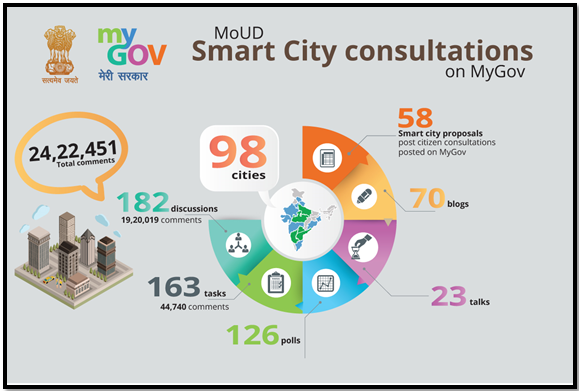AN OVERVIEW OF THE SMART CITIES MISSION
Date:- 14.05.24
SYLLABUS:
- GS 2: Welfare schemes for vulnerable sections of the population by the Centre and States and the performance of these schemes; mechanisms, laws, institutions and Bodies constituted for the protection and betterment of these vulnerable sections.
Focus:
- Out of 100 cities, nearly 50% smart cities have not implemented any projects under the Public-Private-Partnership (PPP) model.
Overview of the Smart Cities Mission (SCM)
- Introduction of SCM: Launched in June 2015 by the NDA-1 government, the SCM aimed to develop 100 cities over five years, adapting to global urbanization trends observed after the 2009 financial crash.
- Definition of Smart Cities: The SCM did not establish a clear definition of “smart cities”; instead, it acknowledged varied interpretations based on developmental levels, willingness for change, and local aspirations.
- Core Components: The mission focused on area-based development (including redevelopment, retrofitting, and greenfield projects) and pan-city solutions that integrated information and communication technologies.
- Investment and Governance: Initially projected at around ₹2.2 lakh crore, the SCM encouraged public-private partnerships and introduced a business model of governance, often bypassing traditional city governance models.
- Current Status: As of April 2024, many projects are behind schedule with total funding reduced to ₹1,67,875 crore, significantly lower than initial projections, and minimal PPP involvement.
Major Aspects of the Smart Cities Mission
- Area-Based Development: This strategy focuses on transforming existing areas (through renewal and retrofitting) and expanding cities with new greenfield projects.
- Pan-City Solutions: Implements city-wide technology solutions to improve e-governance, waste, water, and energy management, urban mobility, and skill development.
- Funding Structure: The mission was primarily funded by government grants and aimed for significant private sector involvement, which has not materialized as expected.
- Special Purpose Vehicle (SPV) Governance: Each smart city project is managed by an SPV created under the Companies Act, minimizing the role of elected local bodies.
- Technology and Infrastructure: Emphasis on integrating advanced technologies for efficient city management and infrastructure development.
Criticisms of the Smart Cities Mission
- Exclusionary Nature: The mission has been criticized for focusing development on less than 1% of the geographical area of the cities, neglecting broader urban challenges.
- Misalignment with the 74th Constitutional Amendment: The SPV governance model does not align well with the amendment meant to empower local governments, leading to conflicts.
- Inadequate Funding Relative to Needs: The funding allocated and spent is a fraction of what is needed to address comprehensive urban challenges in India, according to McKinsey reports.
- Impact on Vulnerable Populations: Implementation of the mission has often led to displacement of poorer communities and disruption of urban commons, affecting street vendors and others.
- Infrastructure Issues: Some infrastructure projects have exacerbated problems like urban flooding by disrupting natural water channels, increasing vulnerability to natural disasters.
Challenges Associated with the Smart Cities Mission
- Extended Deadlines: Originally set to conclude in June 2023, the Smart Cities Mission has been extended to June 2024 to accommodate the completion of pending projects.
- Funding Shortfalls: Central Funding: Regions like Lakshadweep, Daman and Diu, Puducherry, and Port Blair received less than 50% of their promised central funds. State/ULB Contributions: Only 28 cities received their full share from states/ULBs, with 14 cities getting less than 60% of the expected funds.
- Inadequate Public-Private Partnerships (PPPs): PPPs were intended to fund 21% of the mission’s projects but only contributed to 6%. Approximately 50 cities failed to secure any PPP funding.
- Loan Funding Deficiencies: The mission aimed to fund 5% of its budget through loans, a target met by only six cities, with less than 54% of the projected amount raised.
- Operational and Coordination Issues: There were frequent changes in leadership with Chief Executive Officers (CEOs) often being transferred, coupled with the lack of a fixed tenure. The State-Level Advisory Forums, crucial for coordination, met irregularly, with some cities like Amravati and Imphal not holding any meetings.
- Absence of Strategic Planning: Master plans, vital for infrastructure and land use planning, were missing in 65% of urban entities as noted in a NITI Ayog report.
Recommendations for Enhancing the Smart Cities Mission
- Expanding Role of Integrated Command and Control Centers (ICCCs): It’s suggested to broaden the scope of ICCCs to include services like health, internal security, and e-governance to ensure more comprehensive urban management.
- Improving Funding Mechanisms: The necessity to explore and rectify why PPPs have underperformed and to implement strategies for more effective fundraising.
- Developing a Separate Strategy for Smaller Cities: A tailored plan for smaller cities, especially in the northeast, to ensure they benefit from the mission, with possible adjustments in central funding contributions.
- Enhancing Governance Structures: Recommendation for appointing CEOs with fixed tenures to ensure accountability, alongside enhancing stakeholder involvement in decision-making processes.
- IT Strategy and Data Privacy: The need for robust cybersecurity measures to protect digital platforms and sensitive data, especially with the increasing reliance on digital technologies in urban management.
- International Collaboration: Leveraging India’s experience in smart city developments to assist and guide similar projects internationally, exemplified by initiatives like the Gelephu Smart City Project in Bhutan.
Source: The Hindu
Mains Practice Question:
Critically evaluate the implementation of the Smart Cities Mission (SCM) launched by the Government of India. Discuss the major aspects of the mission and analyze why it has been considered exclusionary by some critics. Also, examine whether the SCM’s governance model aligns with the 74th Constitutional Amendment. (250 words)
Associated Articles:




